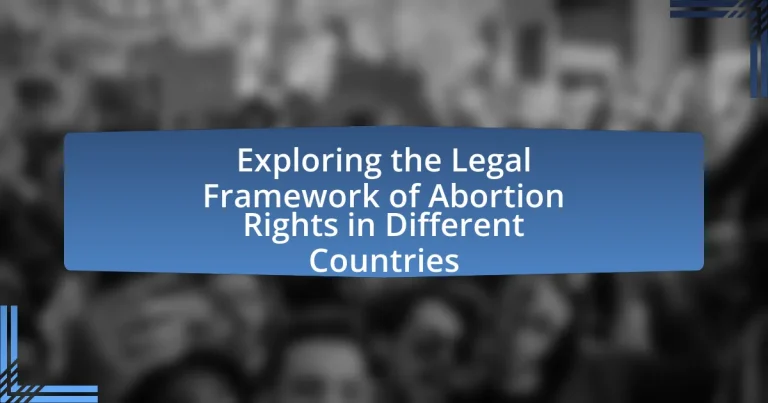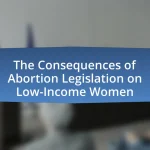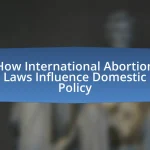The article examines the legal framework of abortion rights across various countries, highlighting the significant differences shaped by cultural, political, and religious influences. It discusses landmark cases such as Roe v. Wade in the United States, where the constitutional right to abortion was established, and contrasts this with countries like Canada, which has no specific laws restricting abortion. The article also explores the definitions of abortion rights, common legal terms, historical contexts, and the impact of international treaties on reproductive rights. Additionally, it addresses the implications of restrictive abortion laws on women’s health and safety, the role of advocacy groups, and strategies for improving abortion rights globally.
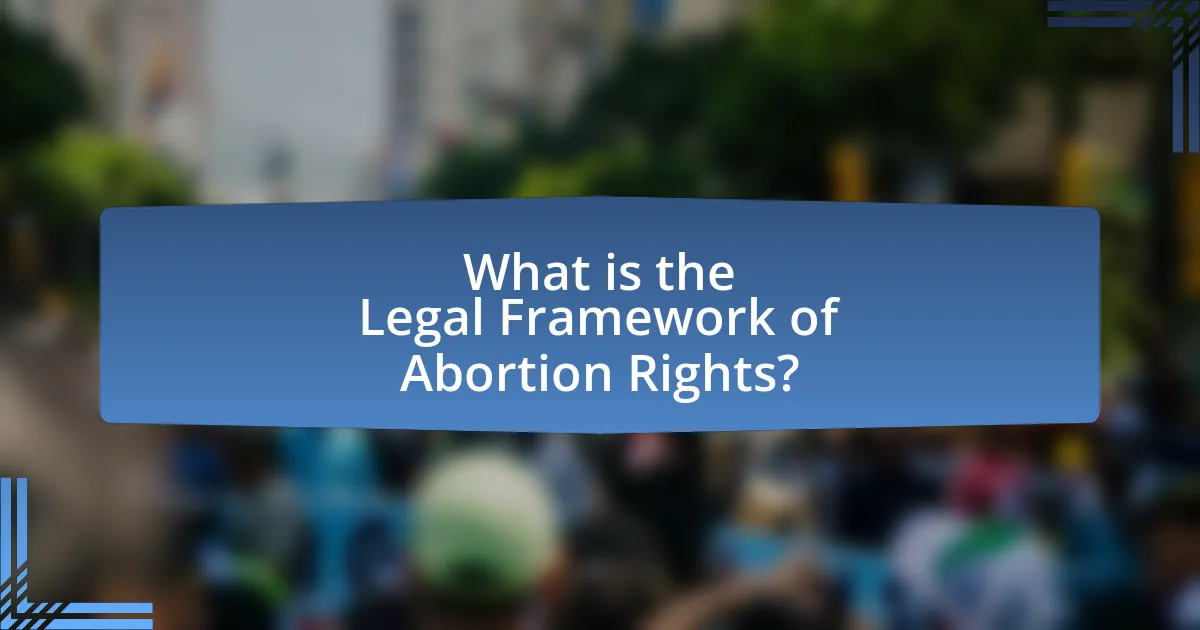
What is the Legal Framework of Abortion Rights?
The legal framework of abortion rights varies significantly across countries, shaped by cultural, political, and religious influences. In the United States, the landmark Supreme Court case Roe v. Wade (1973) established a woman’s legal right to choose an abortion under the constitutional right to privacy, although this has been challenged and modified by subsequent rulings and state laws. In contrast, countries like Canada have no specific laws restricting abortion, allowing it to be performed at any stage of pregnancy based on a woman’s choice. Conversely, many nations, particularly in Latin America and parts of Africa, impose strict regulations or outright bans on abortion, often only permitting it in cases of rape, incest, or when the woman’s life is at risk. These variations illustrate the complex interplay of legal, ethical, and social factors that define abortion rights globally.
How do different countries define abortion rights?
Different countries define abortion rights through varying legal frameworks that reflect cultural, religious, and political contexts. For instance, in the United States, the landmark Supreme Court case Roe v. Wade established a woman’s legal right to choose an abortion under the constitutional right to privacy, although this has been challenged and modified by subsequent rulings. In contrast, countries like Canada have no specific laws restricting abortion, allowing it to be treated as a medical procedure, while nations such as Poland impose strict limitations, permitting abortion only in cases of severe fetal abnormalities or threats to the mother’s health. These definitions are influenced by historical precedents, societal values, and ongoing debates surrounding reproductive rights, illustrating the complexity and diversity of abortion legislation worldwide.
What legal terms are commonly used in abortion legislation?
Common legal terms used in abortion legislation include “gestational limits,” “informed consent,” “medical necessity,” “viability,” “parental consent,” and “criminalization.” Gestational limits refer to the maximum period during which an abortion can legally be performed, often defined in weeks of pregnancy. Informed consent mandates that individuals seeking an abortion must be provided with specific information about the procedure and its risks. Medical necessity is a term used to justify an abortion when the health of the pregnant individual is at risk. Viability indicates the point at which a fetus can survive outside the womb, often influencing legal restrictions. Parental consent laws require minors to obtain permission from a parent or guardian before undergoing an abortion. Criminalization refers to laws that impose penalties on individuals or providers who perform abortions outside of legal parameters. These terms are foundational in shaping the legal landscape surrounding abortion rights in various jurisdictions.
How do definitions of abortion vary across jurisdictions?
Definitions of abortion vary significantly across jurisdictions, influenced by cultural, legal, and political factors. For instance, some countries define abortion as the termination of pregnancy at any stage, while others impose gestational limits, such as allowing abortion only within the first trimester. In the United States, definitions can differ by state; some states permit abortion up to viability, while others have enacted laws restricting it much earlier. Additionally, certain jurisdictions may include specific conditions under which abortion is permitted, such as threats to the mother’s health or cases of fetal anomalies. These variations reflect the diverse legal frameworks and societal attitudes towards reproductive rights globally.
What are the historical contexts influencing abortion laws?
Historical contexts influencing abortion laws include religious beliefs, societal norms, and significant legal milestones. For instance, in the 19th century, many countries criminalized abortion influenced by religious doctrines that viewed it as morally unacceptable. The landmark 1973 U.S. Supreme Court case Roe v. Wade established a constitutional right to abortion, reflecting changing societal attitudes towards women’s rights and bodily autonomy. Additionally, international human rights frameworks, such as the Convention on the Elimination of All Forms of Discrimination Against Women, have pressured nations to reconsider restrictive abortion laws, highlighting the global shift towards recognizing reproductive rights as fundamental human rights.
How have historical events shaped current abortion rights?
Historical events have significantly shaped current abortion rights by influencing legal frameworks and societal attitudes. The landmark 1973 U.S. Supreme Court case Roe v. Wade established a constitutional right to abortion, which set a precedent for reproductive rights and inspired similar movements globally. Additionally, the feminist movements of the 1960s and 1970s advocated for women’s autonomy over their bodies, leading to legislative changes in various countries. For instance, countries like Canada decriminalized abortion in 1988, reflecting shifts in public opinion and legal interpretations. These historical milestones demonstrate how past events have directly impacted the evolution of abortion rights today.
What role do cultural attitudes play in the evolution of abortion laws?
Cultural attitudes significantly influence the evolution of abortion laws by shaping public opinion and political discourse. In societies where conservative views dominate, abortion laws tend to be more restrictive, reflecting the belief that life begins at conception. For instance, countries like Poland have stringent abortion regulations largely due to strong Catholic values that oppose abortion. Conversely, in more liberal societies, such as Canada, cultural attitudes favor women’s rights and bodily autonomy, leading to more permissive abortion laws. Research by the Guttmacher Institute indicates that countries with progressive cultural attitudes towards gender equality and reproductive rights are more likely to have supportive abortion legislation. Thus, cultural attitudes serve as a critical determinant in the legal landscape surrounding abortion.
What are the key international treaties related to abortion rights?
The key international treaties related to abortion rights include the Convention on the Elimination of All Forms of Discrimination Against Women (CEDAW), the International Covenant on Civil and Political Rights (ICCPR), and the International Covenant on Economic, Social and Cultural Rights (ICESCR). CEDAW, adopted in 1979, explicitly addresses women’s rights and has been interpreted to include reproductive rights, including access to safe abortion. The ICCPR, established in 1966, emphasizes the right to life and personal liberty, which has been linked to the right to make decisions about one’s own body, including abortion. The ICESCR, also from 1966, recognizes the right to health, which encompasses access to safe and legal abortion services. These treaties collectively form a framework that supports the recognition and protection of abortion rights at the international level.
How do international human rights frameworks address abortion?
International human rights frameworks address abortion primarily through the recognition of women’s rights to health, privacy, and non-discrimination. The United Nations Human Rights Committee has interpreted the International Covenant on Civil and Political Rights to include the right to access safe and legal abortion under certain circumstances, emphasizing that restrictive abortion laws can violate women’s rights to life and health. Additionally, the Convention on the Elimination of All Forms of Discrimination Against Women calls for states to ensure women’s access to healthcare services, including reproductive health, which encompasses abortion. These frameworks highlight the necessity of balancing fetal rights with women’s rights, advocating for legal reforms that protect women’s autonomy and health.
What obligations do countries have under international law regarding abortion?
Countries have obligations under international law to ensure access to safe and legal abortion services, as recognized by various human rights treaties. For instance, the Convention on the Elimination of All Forms of Discrimination Against Women (CEDAW) emphasizes women’s rights to make decisions about their reproductive health, which includes access to abortion. Additionally, the International Covenant on Civil and Political Rights (ICCPR) mandates that states respect the right to life, which has been interpreted by the Human Rights Committee to include the right to access safe abortion services when necessary to protect women’s health or life. These obligations are reinforced by recommendations from international bodies, such as the World Health Organization, which advocate for the decriminalization of abortion and the provision of comprehensive reproductive health services.
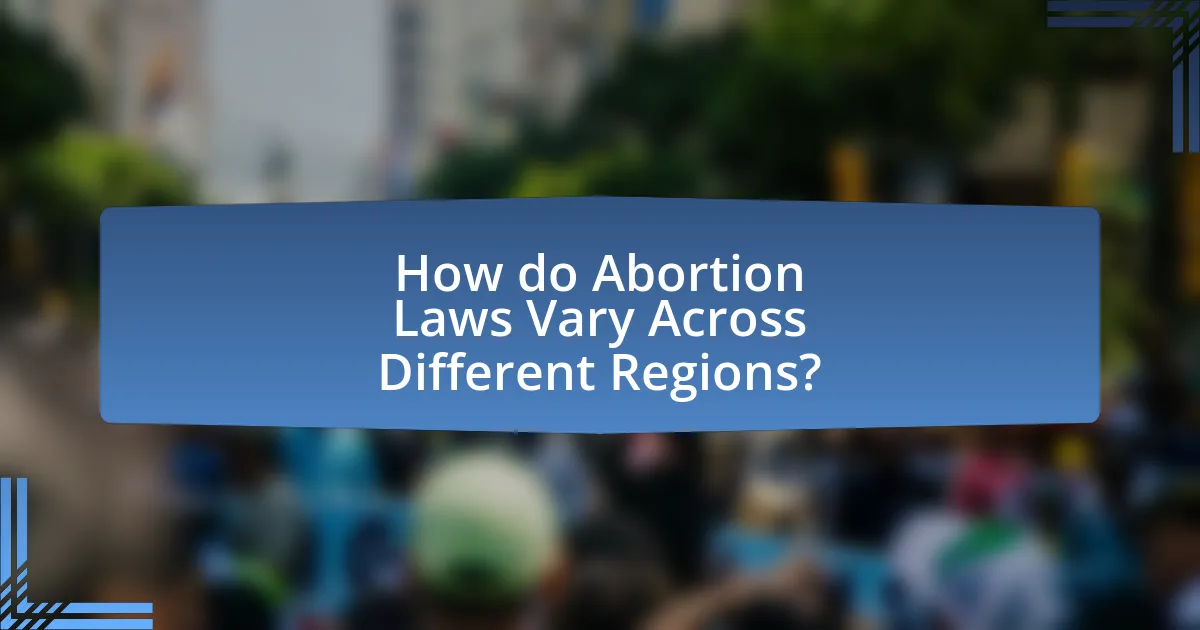
How do Abortion Laws Vary Across Different Regions?
Abortion laws vary significantly across different regions, reflecting diverse cultural, religious, and political contexts. For instance, in North America, countries like Canada allow abortion on demand without gestational limits, while in the United States, laws differ by state, with some states imposing strict regulations or bans. In Europe, nations such as the Netherlands and Sweden provide access to abortion services under liberal frameworks, whereas countries like Poland have enacted stringent restrictions, allowing abortion only in cases of severe fetal anomalies or threats to the mother’s health. In contrast, many countries in Latin America, such as El Salvador and Nicaragua, have total bans on abortion, regardless of circumstances. These variations illustrate the complex interplay of legal, social, and ethical considerations surrounding abortion rights globally.
What are the legal frameworks for abortion in North America?
The legal frameworks for abortion in North America vary significantly by country and region. In the United States, the Supreme Court’s decision in Roe v. Wade (1973) established a constitutional right to abortion, which was later overturned by Dobbs v. Jackson Women’s Health Organization in 2022, allowing states to regulate abortion laws independently. Consequently, some states have enacted restrictive laws, while others maintain access to abortion services. In Canada, abortion is legal at all stages of pregnancy, with no specific criminal laws governing the procedure, following the 1988 Supreme Court ruling in R v. Morgentaler that decriminalized abortion. Mexico’s legal framework varies by state; while some states have legalized abortion up to 12 weeks, others impose stricter regulations. These frameworks reflect the diverse legal landscapes regarding abortion rights across North America.
How do state laws in the United States differ regarding abortion?
State laws in the United States differ significantly regarding abortion, with some states enacting restrictive measures while others protect access. For instance, states like Texas and Alabama have implemented laws that severely limit abortion access, including mandatory waiting periods, parental consent requirements, and gestational limits. Conversely, states such as California and New York have established laws that safeguard abortion rights, allowing access up to viability and beyond in certain circumstances. The Supreme Court’s decision in Dobbs v. Jackson Women’s Health Organization in 2022 further empowered states to regulate abortion, leading to a patchwork of laws across the country, reflecting varying political, cultural, and social attitudes toward reproductive rights.
What is the legal status of abortion in Canada?
Abortion is legal in Canada at all stages of pregnancy. The Supreme Court of Canada decriminalized abortion in 1988 through the R v. Morgentaler decision, which ruled that existing laws restricting access to abortion violated a woman’s right to security of the person under the Canadian Charter of Rights and Freedoms. Consequently, there are no criminal laws governing abortion, making it accessible through healthcare services across the country.
What are the abortion laws in Europe?
Abortion laws in Europe vary significantly by country. In many Western European nations, such as France and Germany, abortion is legal on request within certain gestational limits, typically up to 12 weeks. In contrast, countries like Poland have restrictive laws, allowing abortion only in cases of severe fetal abnormalities or when the mother’s life is at risk. According to the European Parliamentary Research Service, as of 2021, 14 EU member states permit abortion on request, while several others impose strict conditions or outright bans. This legal landscape reflects diverse cultural, religious, and political contexts across Europe.
How do Western European countries approach abortion rights?
Western European countries generally approach abortion rights with a framework that supports access to safe and legal abortion services. For instance, countries like the Netherlands and Sweden allow abortions on request during the first trimester, reflecting a commitment to reproductive rights. In contrast, nations such as Ireland have historically imposed stricter regulations, although recent reforms have liberalized access. The European Union also influences these policies, promoting women’s health and rights through various directives and funding initiatives. This collective approach underscores a trend towards recognizing abortion as a fundamental aspect of healthcare and personal autonomy in Western Europe.
What are the restrictions on abortion in Eastern European countries?
Abortion restrictions in Eastern European countries vary significantly, with some nations imposing strict regulations while others allow more liberal access. For instance, Poland has one of the most restrictive abortion laws in Europe, permitting the procedure only in cases of severe fetal abnormalities, rape, or incest. In contrast, countries like Romania and Bulgaria allow abortions on request during the first trimester, with Romania permitting abortions up to 14 weeks of gestation. Additionally, Hungary has restrictions that require mandatory counseling and a waiting period, while Slovakia allows abortions up to 12 weeks but mandates counseling and a waiting period as well. These variations reflect differing cultural, religious, and political influences across the region.
What is the situation regarding abortion rights in Asia and Africa?
Abortion rights in Asia and Africa vary significantly by country, reflecting diverse legal frameworks and cultural attitudes. In Asia, countries like India and Nepal have relatively liberal laws allowing abortion under specific circumstances, while others, such as the Philippines, maintain strict prohibitions with limited exceptions. For instance, India permits abortion up to 20 weeks under certain conditions, while Nepal allows it up to 12 weeks without restrictions.
In Africa, the situation is more restrictive overall, with countries like South Africa having legalized abortion on demand up to 12 weeks, contrasting sharply with nations such as Nigeria and Egypt, where abortion is heavily restricted or illegal except to save a woman’s life. According to the World Health Organization, only 4% of women in Africa have access to safe abortion services, highlighting the significant barriers faced across the continent.
These disparities illustrate the complex interplay of legal, social, and health factors influencing abortion rights in both regions.
How do cultural and religious beliefs influence abortion laws in these regions?
Cultural and religious beliefs significantly influence abortion laws in various regions by shaping societal attitudes and legal frameworks surrounding the issue. For instance, in predominantly Catholic countries like Poland and Malta, strong religious opposition to abortion has led to restrictive laws, often allowing it only in cases of severe fetal abnormalities or threats to the mother’s life. Conversely, in more secular societies, such as those in Scandinavia, cultural acceptance of reproductive rights has resulted in more liberal abortion laws, permitting access with fewer restrictions. This correlation between belief systems and legal regulations is evident in the varying degrees of access to abortion services, reflecting the underlying values and norms of each society.
What are the legal challenges faced by women seeking abortions in these areas?
Women seeking abortions in various regions face significant legal challenges, including restrictive laws, mandatory waiting periods, and parental consent requirements. In many countries, laws limit the circumstances under which abortions can be performed, often only allowing them in cases of rape, incest, or when the mother’s life is at risk. For instance, in some U.S. states, laws have been enacted that impose waiting periods of up to 72 hours, which can create barriers for women needing timely access to care. Additionally, parental consent laws in several jurisdictions require minors to obtain permission from a parent or guardian, complicating access for younger women. These legal hurdles can lead to delays, increased costs, and in some cases, force women to seek unsafe alternatives.
What are the Implications of Abortion Laws on Women’s Rights?
Abortion laws significantly impact women’s rights by determining their autonomy over reproductive choices. In countries with restrictive abortion laws, women often face barriers to accessing safe and legal abortion services, which can lead to negative health outcomes and increased maternal mortality rates. For instance, the World Health Organization reports that unsafe abortions contribute to approximately 47,000 deaths annually, primarily in regions where abortion is heavily restricted. Furthermore, restrictive laws can perpetuate gender inequality by limiting women’s ability to make decisions about their own bodies, thereby infringing on their rights to privacy, health, and equality. In contrast, countries with more liberal abortion laws tend to support women’s rights by promoting access to reproductive healthcare and empowering women to make informed choices about their lives.
How do restrictive abortion laws affect women’s health and safety?
Restrictive abortion laws negatively impact women’s health and safety by limiting access to safe and legal abortion services. When these laws are enacted, women may resort to unsafe methods to terminate pregnancies, leading to increased rates of complications, maternal mortality, and mental health issues. For instance, a study published in The Lancet found that countries with highly restrictive abortion laws have significantly higher rates of unsafe abortions, contributing to an estimated 47,000 maternal deaths annually worldwide. Furthermore, restrictive laws can exacerbate existing health disparities, particularly among marginalized groups, as they often lack the resources to seek safe alternatives.
What are the health risks associated with unsafe abortions?
Unsafe abortions pose significant health risks, including severe complications such as hemorrhage, infection, and injury to internal organs. According to the World Health Organization, approximately 47,000 women die each year due to complications from unsafe abortions, highlighting the critical nature of this issue. Additionally, unsafe procedures can lead to long-term health problems, including infertility and chronic pain. The lack of access to safe abortion services increases the likelihood of these health risks, particularly in regions with restrictive abortion laws.
How do legal barriers impact women’s access to healthcare services?
Legal barriers significantly restrict women’s access to healthcare services, particularly in reproductive health. For instance, restrictive abortion laws can lead to increased rates of unsafe procedures, as women may resort to illegal means when legal options are unavailable. According to the World Health Organization, approximately 25 million unsafe abortions occur each year, primarily in countries with stringent abortion laws. Furthermore, legal restrictions can deter healthcare providers from offering necessary services due to fear of legal repercussions, thereby limiting the availability of comprehensive care. This creates a cycle where women’s health outcomes deteriorate due to a lack of access to safe and legal healthcare options.
What role do advocacy groups play in shaping abortion rights?
Advocacy groups play a crucial role in shaping abortion rights by influencing public policy, raising awareness, and mobilizing grassroots support. These organizations, such as Planned Parenthood and the Center for Reproductive Rights, engage in lobbying efforts to promote legislation that protects or expands access to abortion services. For instance, in the United States, advocacy groups have been instrumental in both defending existing rights established by landmark cases like Roe v. Wade and pushing for new laws that enhance reproductive health access. Additionally, they conduct research and disseminate information to educate the public and policymakers about the implications of abortion rights, thereby shaping the legal framework surrounding the issue. Their efforts have led to significant changes in abortion laws in various countries, reflecting the power of organized advocacy in influencing legal outcomes.
How do grassroots movements influence abortion legislation?
Grassroots movements significantly influence abortion legislation by mobilizing public opinion, advocating for policy changes, and increasing political pressure on lawmakers. These movements often engage in campaigns that raise awareness about reproductive rights, which can shift societal attitudes and lead to legislative reforms. For instance, the Women’s March and organizations like Planned Parenthood have successfully lobbied for changes in laws and policies regarding abortion access in various states. Research indicates that states with active grassroots organizations advocating for reproductive rights tend to have more progressive abortion laws, as seen in California and New York, where public support for abortion rights has been bolstered by grassroots activism.
What strategies do organizations use to promote reproductive rights?
Organizations promote reproductive rights through advocacy, education, and legal reform initiatives. Advocacy efforts often involve lobbying governments to enact or protect laws that ensure access to reproductive health services, including abortion. For instance, organizations like Planned Parenthood engage in political campaigns to influence legislation and public policy. Education initiatives focus on raising awareness about reproductive health issues, providing information on rights, and combating misinformation. Legal reform efforts include filing lawsuits to challenge restrictive laws and working to establish legal precedents that support reproductive rights, as seen in cases like Roe v. Wade in the United States. These strategies collectively aim to create a supportive legal and social environment for reproductive rights.
What can be done to improve abortion rights globally?
To improve abortion rights globally, countries must reform restrictive laws and ensure access to safe and legal abortion services. Evidence shows that nations with liberal abortion laws, such as Canada and the Netherlands, experience lower rates of unsafe abortions and better maternal health outcomes. Additionally, international organizations like the World Health Organization advocate for the decriminalization of abortion and the integration of reproductive health services into primary healthcare systems, which can further enhance access and safety.
What best practices can be adopted from countries with progressive abortion laws?
Countries with progressive abortion laws often implement best practices such as comprehensive sex education, accessible healthcare services, and supportive legal frameworks. Comprehensive sex education, as seen in countries like the Netherlands, reduces unintended pregnancies and empowers individuals with knowledge about reproductive health. Accessible healthcare services, exemplified by Sweden, ensure that abortion is safe, legal, and available without excessive barriers, leading to lower maternal mortality rates. Supportive legal frameworks, like those in Canada, protect the right to choose and eliminate stigma, fostering an environment where individuals can make informed decisions about their reproductive health. These practices collectively contribute to better health outcomes and uphold reproductive rights.
How can international cooperation enhance women’s reproductive rights?
International cooperation can enhance women’s reproductive rights by facilitating the sharing of best practices, legal frameworks, and resources among countries. Collaborative efforts, such as international treaties and agreements, can establish common standards for reproductive health services, ensuring that women have access to safe and legal abortion options. For instance, the United Nations’ Sustainable Development Goals emphasize gender equality and reproductive health, encouraging nations to adopt policies that protect women’s rights. Additionally, organizations like the World Health Organization provide guidelines and support for countries to improve their reproductive health systems, which can lead to better outcomes for women globally.
